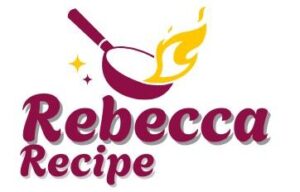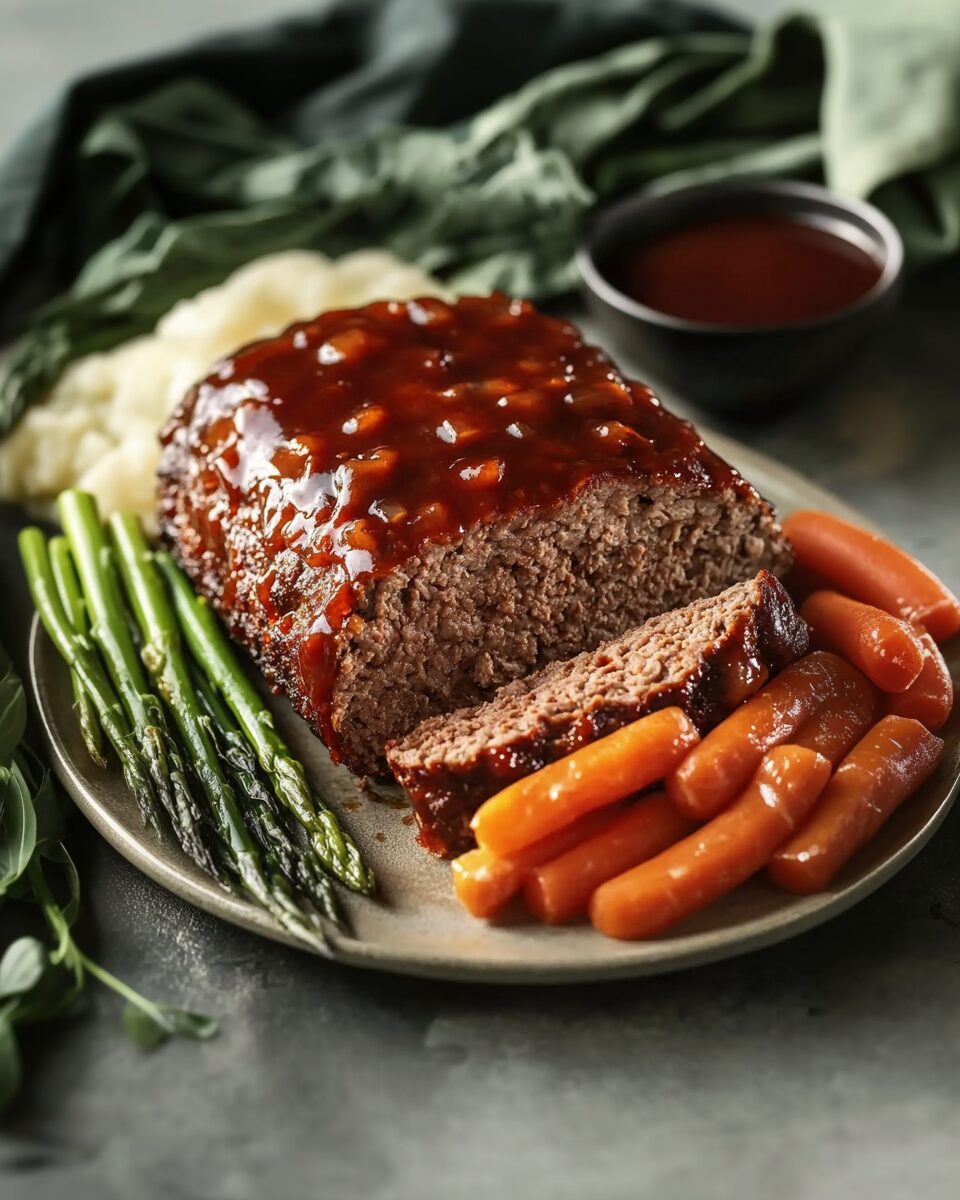This classic meatloaf recipe is the epitome of comfort food, bringing back memories of family gatherings and home-cooked meals. With its savory blend of ground beef, sautéed onions, and a tangy glaze, it’s a hearty dish that’s both satisfying and nostalgic.
Full Recipe:
Ingredients
- 1 ½ pounds ground beef
- 1 cup breadcrumbs
- 1 small onion, finely chopped
- 2 cloves garlic, minced
- 1 large egg
- ¾ cup milk
- ¼ cup ketchup
- 2 tablespoons Worcestershire sauce
- 1 teaspoon salt
- ½ teaspoon black pepper
- ½ teaspoon dried thyme
- ½ teaspoon dried oregano
- ½ cup ketchup (for topping)
Directions
- Preheat your oven to 350°F (175°C).
- In a large mixing bowl, combine the ground beef, breadcrumbs, chopped onion, minced garlic, egg, milk, ¼ cup ketchup, Worcestershire sauce, salt, black pepper, thyme, and oregano. Mix until just combined; avoid over-mixing to keep the meatloaf tender.
- Transfer the mixture to a lightly greased loaf pan or shape it into a loaf on a baking sheet lined with parchment paper.
- Spread the remaining ½ cup of ketchup evenly over the top of the meatloaf.
- Bake for about 1 hour, or until the internal temperature reaches 160°F (70°C).
- Remove from the oven and let it rest for about 10 minutes before slicing.
Nutritional Facts
While exact nutritional values can vary based on specific ingredients used, a typical serving of this meatloaf (assuming 6 servings total) contains approximately:
- Calories: 280
- Protein: 20g
- Fat: 15g
- Carbohydrates: 15g
- Fiber: 2g
- Sodium: 700mg
Cultural Significance of Meatloaf
In the United States, meatloaf holds a special place as a comfort food that symbolizes home, family, and tradition. It’s often associated with family dinners, potlucks, and holiday gatherings. The dish represents warmth and nurturing, evoking memories of a home-cooked meal prepared with love. It has been featured in countless cookbooks, TV shows, and cultural references, reinforcing its status as a quintessential American dish.
Beyond America, meatloaf variations appear worldwide, each bringing its own twist. For instance, Swedish meatballs and German “Hackbraten” show the diversity of ground meat dishes seasoned and shaped similarly to meatloaf. This diversity underscores the universal appeal of combining meat and fillers to create hearty, flavorful meals.
Nutritional Value and Health Benefits
Meatloaf offers a balanced combination of macronutrients, primarily protein, fats, and carbohydrates, especially when combined with ingredients like breadcrumbs and vegetables. Protein from the ground beef is essential for muscle repair, immune function, and overall health. The dish also provides important micronutrients like iron, zinc, and B vitamins, which are crucial for energy production and cognitive function.
Incorporating vegetables such as onions and garlic adds antioxidants and dietary fiber, which support digestion and immune health. Using lean ground beef or mixing beef with other meats like turkey can reduce the fat content, making the meatloaf a healthier option. Additionally, whole grain breadcrumbs can boost the fiber content further.
One thing to consider is the sodium level, which can be moderated by adjusting added salt and using lower-sodium ketchup or Worcestershire sauce. Balancing these ingredients helps create a nutritious yet flavorful dish.
Variations and Adaptations
Meatloaf is incredibly versatile and can be adapted to fit various dietary preferences and flavor profiles. Some popular variations include:
-
Turkey or Chicken Meatloaf: Leaner options that reduce fat content while maintaining protein levels.
-
Vegetarian Meatloaf: Made with lentils, beans, mushrooms, or textured vegetable protein to mimic the texture and protein content of meat.
-
Gluten-Free Meatloaf: Using gluten-free breadcrumbs or substitutes like oats or crushed nuts.
-
International Flavors: Adding spices and herbs like cumin, paprika, or curry powder for a global twist.
-
Cheese-Stuffed Meatloaf: Incorporating cheese inside the loaf for a creamy surprise.
-
Vegan Meatloaf: Using plant-based ingredients such as beans, mushrooms, flax eggs, and nutritional yeast to replace meat and binders.
These variations showcase how adaptable meatloaf is, allowing cooks to cater to different tastes, dietary restrictions, and ingredient availability.
Serving Suggestions
Meatloaf pairs beautifully with a wide range of sides, making it a versatile main course. Classic accompaniments include mashed potatoes, green beans, steamed vegetables, or a fresh garden salad. For a more indulgent meal, creamy mashed potatoes with gravy or cheesy scalloped potatoes complement the savory meatloaf flavors.
For a lighter meal, serve meatloaf slices with roasted vegetables, quinoa, or a crisp coleslaw. The tangy ketchup glaze on top adds a nice balance to rich sides, while additional condiments like mustard or BBQ sauce can provide extra flavor.
Leftover meatloaf is also fantastic as a sandwich filling, offering a quick and satisfying lunch option. Layer slices with lettuce, tomato, and a smear of mayo or mustard on toasted bread for a hearty sandwich.
Tips for the Perfect Meatloaf
-
Don’t Overmix: Mixing the meat and ingredients too much can make the meatloaf dense and tough. Mix just until combined for a tender texture.
-
Use Fresh Ingredients: Fresh onions, garlic, and herbs make a significant difference in flavor.
-
Rest Before Slicing: Letting the meatloaf rest after baking allows juices to redistribute, making slicing easier and the meatloaf juicier.
-
Use a Meat Thermometer: Cooking to an internal temperature of 160°F ensures the meatloaf is fully cooked but not overdone.
-
Add Moisture: Ingredients like milk, eggs, and ketchup help keep the meatloaf moist.
-
Customize Your Topping: While ketchup is traditional, try BBQ sauce, tomato sauce, or even a glaze made from mustard and brown sugar.
Why This Old-Fashioned Meatloaf Recipe Stands Out
This particular recipe strikes the perfect balance between traditional flavors and ease of preparation. It uses simple, familiar ingredients that are pantry staples, making it accessible for most home cooks. The combination of Worcestershire sauce and ketchup in the mix and as a topping creates a tangy, savory glaze that enhances the flavor without overpowering it.
The recipe is also forgiving, allowing for adjustments based on personal preferences or available ingredients. It embodies the classic American meatloaf style while maintaining a moist, tender texture that’s often hard to achieve.
Conclusion
Meatloaf remains a timeless dish that continues to bring comfort and satisfaction to countless tables. Its rich history and cultural significance make it more than just a meal — it’s a culinary tradition that connects generations. Whether served for a cozy family dinner or a holiday feast, meatloaf delivers warmth, flavor, and nourishment. By choosing quality ingredients and following a tried-and-true recipe, you can create a meatloaf that is both delicious and nutritious. With endless possibilities for variation and adaptation, meatloaf offers something for everyone, from traditionalists to modern foodies.








